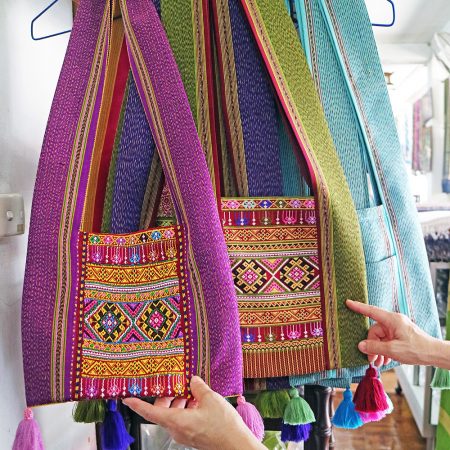The Thai Fabric Chronicles continue! This time with a look at a Hill tribe tradition-Yaams!

Yaam! It rhymes with Guam, mom, and bomb. It’s a northern Thai word that refers to a traditional and specific kind Hill tribe handbag of sorts.
A yaam is not a shoulder bag, nor a tote with long straps. It’s not a purse, pouch, or satchel. And above all else, it’s not a bright orange vegetable that Americans serve at Thanksgiving.
A yaam doesn’t care about size. There are huge yaams and baby yaams. There are fat yaams and skinny ones. Yaams are neither boy or girl-they are unisex. Yaams are not trendy or boho (short for bohemian)-they’ve been around for a thousand years at least.
What is a yaam?

And more yaams.

A picture says a thousand words and that’s why this post has lots of photos of what is and isn’t a yaam.
A yaam is a squarish kind of shoulder bag with a very long strap that is sewn on the extreme top corners of the bag. If the bag is not squarish (it doesn’t have to be a perfect square) or the straps are sewn anywhere but on the corners, it’s not a yaam.
It is almost always made from cotton fabric, but I’ve also seen them made from hemp, burlap, and even Thai silk. The Hmong Hill tribe is famous for making cotton embroidered yaams.

Construction of a yaam is simple. Just cut a rectangular piece of fabric where the length is twice as long as the width. Fold it over and sew up the sides. Attach at the top corners a very long, wide shoulder strap and you’ve got a basic yaam. You can add a zipper or button/flap to secure the top, but it’s not required. Yaams usually don’t have any interior pockets.
The Soul of a Yaam-The Strap

The soul of a yaam is the shoulder strap. I say this because many purses or handbags would be yaams if they had looooong shoulder straps at the corners. So often it’s the shoulder strap that determines whether a handbag is a traditional yaam.

The yaam shoulder strap is often very broad. Four to six inches is a common width for yaam straps. And the strapping must be long enough so that the yaam can be slung across your hip. The top of the yaam should be worn about belt high. It’s not uncommon for shorter people to tie the strap into a knot to take up some extra length so the yaam doesn’t hang down to their knees.
Yaams are usually worn across the chest down over the hip. That wide strap is designed to come across your upper body.
There are three good reasons why the strap is so long and broad: strength, comfort, and security. Strength because bigger yaams can be relied upon for carrying heavy loads. Comfort because the broader the strap, the more comfortable it is on your shoulder. Security because when you wear it across your body, nobody is going to snatch your yaam. Nobody!
The Art of the Yaam


While the construction of the yaam is rudimentary, the art of the yaam is endless. They range from the drab and plain to the wildly flamboyant. They can be garnished with beads, feathers, buttons, fabric swatches, metal trinkets (the expensive ones will use real silver), coins, strands of colorful yarn, embroidery or leather.
Yaams are Hill tribe, and so the art of the yaam follows the same cultural path as so much other Hill tribe apparel. The same notions that are used to trim and decorate Hill tribe apparel are the same ones used to decorate and embellish a yaam.
The Hill tribes

For those unfamiliar with indigenous Hill Tribe people, allow me a brief paragraph. Throughout northern Thailand, Laos, Burma and Yunnan Province in southern China, indigenous people of independent tribes-Hill tribes-have lived for thousands of years. The Hmong, Lisu, Karen, Akha, Yao, Meo, Lahu are just a few of the dozens of tribes.
They each speak their own language and have their own cultures. They live in the mountains of northern Thailand, Burma, Laos and Yunnan (The Golden Triangle) and over the centuries have migrated south into northern Thailand.
These Hill tribes are where yaams were first designed and used. Hill tribes would bring their wares to Chiang Rai and Chiang Mai to sell and yaams became popular with Thais. Now they’re a ubiquitous handbag that can be found anywhere in the country.
Just a personal note: Think twice before going on a “Hill tribe trek” in Thailand. These treks are just tourist traps. Besides, a Hill tribe village is not a zoo.
A Yaam is a Yaam

I hate to dispel someone of a romantic notion. I don’t want to tell you that Santa doesn’t exist. But, most yaams you’ll see for sale are not made by a Hill tribe artisan. Pay attention! I said most, not all. You can still find Hill tribe made yaams, but it’s not easy.
Most Hill tribe apparel and handbags are made in and around Chiang Mai by Thais. The reason is simple: The demand both domestic and from tourists is huge for Hill tribe wares. The Hill tribes could never satisfy this demand alone, and so Thais produce much of what is called “Hill tribe”. Today, “Hill tribe” is more of a fashion genre than a statement about who made it.
Yaams make great gifts. They’re cheap-usually between $5-$20 (US), and they take up little room in your suitcase. And of course a yaam exudes northern Thai culture.


Leave a Reply